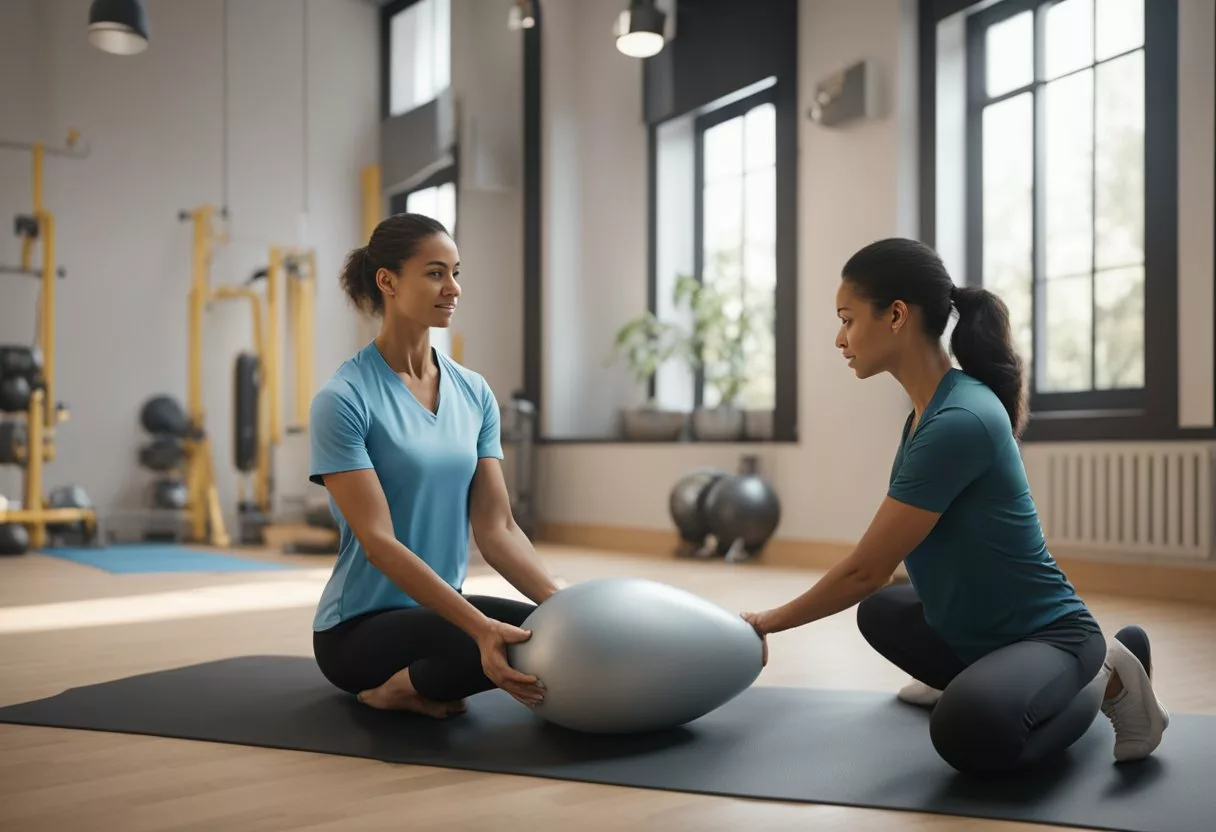Pelvic floor exercises are a form of exercise that target the muscles located in the pelvic region. These muscles are responsible for supporting the bladder, uterus, and rectum, and are often weakened due to pregnancy, childbirth, aging, or surgery.
Pelvic floor exercises can help strengthen these muscles, leading to improved bladder and bowel control, as well as enhanced sexual function.
Both men and women can benefit from pelvic floor exercises, as weak pelvic floor muscles can lead to urinary and fecal incontinence, as well as sexual dysfunction.
In women, pregnancy and childbirth can cause these muscles to weaken, while men may experience weakened pelvic floor muscles due to prostate surgery or aging.
Pelvic floor exercises can help prevent or alleviate these issues, leading to a better quality of life.
Key Takeaways:
- Pelvic floor exercises can improve bladder and bowel control, as well as sexual function.
- Both men and women can benefit from pelvic floor exercises.
- Weak pelvic floor muscles can lead to urinary and fecal incontinence, as well as sexual dysfunction.
Understanding the Pelvic Floor

The pelvic floor is a group of muscles and connective tissue that span the area beneath the pelvis. It is responsible for supporting the pelvic organs, including the uterus, bladder, rectum, and anus.
The pelvic floor muscles also play a vital role in sexual function, bowel and bladder control, and core stability.
Anatomy of the Pelvic Floor
The pelvic floor is composed of three layers of muscles that run from the pubic bone to the tailbone. The muscles are arranged in a figure-eight shape around the openings of the urethra, vagina, and anus.
Additionally, the pelvic floor muscles are divided into two types: the superficial muscles and the deep muscles. The superficial muscles are responsible for supporting the pelvic organs and maintaining continence, while the deep muscles provide stability and support to the pelvis.
Functions of Pelvic Floor Muscles
The pelvic floor muscles play a critical role in the body’s overall health and well-being. They are responsible for controlling the flow of urine and feces, supporting the pelvic organs, and maintaining sexual function.
When the pelvic floor muscles are weak or damaged, it can lead to a range of health problems, including urinary incontinence, fecal incontinence, pelvic organ prolapse, and sexual dysfunction.
Common Pelvic Floor Disorders
Pelvic floor disorders are common, affecting millions of people worldwide. Some of the most common pelvic floor disorders include urinary incontinence, fecal incontinence, pelvic organ prolapse, and sexual dysfunction.
These conditions can be caused by a range of factors, including pregnancy and childbirth, aging, obesity, and chronic constipation.
Benefits of Pelvic Floor Exercises
Pelvic floor exercises, also known as Kegels, offer numerous benefits for both men and women. These exercises target the muscles that support the bladder, uterus, and rectum, and can help improve continence, enhance sexual function, and support organs to prevent prolapse.
Improving Continence
Pelvic floor exercises can help improve bladder and bowel control, reducing the frequency and severity of incontinence.
Incontinence can be caused by weakened pelvic floor muscles, and regular Kegels can help strengthen these muscles and improve overall continence. Both urinary and fecal incontinence can be improved with pelvic floor exercises.
Enhancing Sexual Function
Pelvic floor exercises can also enhance sexual function by improving orgasm intensity and reducing pain during intercourse.
Strong pelvic floor muscles can help increase blood flow to the genitals and improve muscle tone, leading to stronger and longer-lasting orgasms. Additionally, pelvic floor exercises can help reduce pain during sex by improving pelvic muscle strength and reducing muscle tension.
Supporting Organs and Preventing Prolapse
Pelvic floor exercises can also help support pelvic organs and prevent prolapse, a condition where the pelvic organs, such as the bladder or uterus, shift out of place.
Prolapse is often caused by weakened pelvic floor muscles, and regular Kegels can help strengthen these muscles and prevent prolapse. By strengthening the pelvic floor muscles, the organs are better supported and less likely to shift out of place.
Pelvic Floor Exercises for Different Populations
Exercises During Pregnancy and Postpartum
Pregnancy and childbirth can weaken the pelvic floor muscles, leading to issues such as urinary incontinence and pelvic organ prolapse. Pelvic floor exercises, also known as Kegels, can help strengthen these muscles.
During pregnancy, it is important to do pelvic floor exercises regularly to prepare for delivery and prevent urinary incontinence. After delivery, pelvic floor exercises can help with recovery and prevent long-term issues.
To perform Kegels during pregnancy and postpartum, contract the pelvic floor muscles for 5-10 seconds, then relax for the same amount of time. Repeat this exercise 10-15 times, 3-4 times a day.
Exercises for Aging Individuals
Aging can also weaken the pelvic floor muscles, leading to issues such as urinary incontinence and prolapse. Pelvic floor exercises can help prevent and manage these issues.
To perform pelvic floor exercises, contract the muscles for 5-10 seconds, then relax for the same amount of time. Repeat this exercise 10-15 times, 3-4 times a day. It may take some time to see results, so consistency is key.
Exercises for Men
Pelvic floor exercises are not just for women. Men can also benefit from these exercises, especially after prostate surgery.
To perform pelvic floor exercises, contract the muscles for 5-10 seconds, then relax for the same amount of time. Repeat this exercise 10-15 times, 3-4 times a day. It may take some time to see results, so consistency is key.
Performing Pelvic Floor Exercises

Pelvic floor exercises can be done by anyone, regardless of age or gender. They are simple exercises that can help strengthen and tone the muscles of the pelvic floor, which can improve bladder and bowel control, as well as sexual function.
There are several different techniques that can be used to perform pelvic floor exercises, including basic techniques and Kegels, advanced exercises and variations, and incorporating equipment and props.
Basic Techniques and Kegels
The most basic technique for performing pelvic floor exercises is known as Kegels. This technique involves contracting and relaxing the muscles of the pelvic floor.
To perform Kegels, a person should sit or lie down in a comfortable position and contract the muscles of the pelvic floor as if they were trying to stop the flow of urine. Hold the contraction for a few seconds and then release. Repeat this process several times, working up to holding the contraction for 10 seconds at a time.
Advanced Exercises and Variations
Once a person has mastered the basic Kegel technique, they can move on to more advanced exercises and variations.
These exercises can help to further strengthen the muscles of the pelvic floor and improve bladder and bowel control.
Some advanced exercises include squats, bridges, clamshell, happy baby pose, and child’s pose. These exercises can be done alone or in combination with other exercises, such as yoga, running, or walking.
Incorporating Equipment and Props
In addition to basic techniques and advanced exercises, a person can also incorporate equipment and props into their pelvic floor exercise routine.
Some equipment and props that can be used include resistance bands, exercise balls, and weights. These tools can help to further strengthen and tone the muscles of the pelvic floor, as well as improve overall fitness and flexibility.
Integrating Pelvic Floor Exercises into Daily Life

Pelvic floor exercises can be done anywhere and at any time, making it easy to integrate them into a daily routine.
By consistently incorporating these exercises into a daily routine, individuals can improve the strength and endurance of their pelvic floor muscles, which can help reduce the risk of urinary incontinence and other pelvic floor disorders.
Creating a Routine
To create a routine, individuals can choose a time of day that works best for them, such as before getting out of bed in the morning, during a lunch break, or before going to bed at night.
By setting aside a few minutes each day, individuals can build consistency and make pelvic floor exercises a habit.
Another way to integrate pelvic floor exercises into a daily routine is to pair them with other activities.
For example, individuals can do pelvic floor exercises while standing in line, brushing their teeth, or waiting for the microwave to finish heating up their food.
By pairing pelvic floor exercises with other activities, individuals can save time and make the most of their daily routine.
Exercise Modifications for Different Activities
It’s important to modify pelvic floor exercises for different activities to ensure that they are effective and safe.
For example, when lifting heavy weights, individuals should engage their pelvic floor muscles before lifting and exhale as they lift the weight. When coughing or sneezing, individuals should engage their pelvic floor muscles to prevent urine leakage.
For individuals with a chronic cough, jumping, or other activities that put pressure on the pelvic floor, it may be helpful to do pelvic floor exercises before and after the activity.
Additionally, individuals should avoid holding their breath during these activities, as this can put additional pressure on the pelvic floor muscles.
Professional Guidance and Physical Therapy

When to Consult a Healthcare Professional
It is recommended to consult with a healthcare professional, such as a doctor or pelvic floor physical therapist, before starting any new exercise routine.
This is especially important if you have a history of pelvic pain, pelvic surgery, or pelvic floor dysfunction.
If you experience pain or discomfort while performing pelvic floor exercises, stop immediately and consult with your healthcare professional. Also, if you are unsure if you are performing the exercises correctly, seek guidance from a pelvic floor physical therapist.
Working with a Physical Therapist
A pelvic floor physical therapist can help individuals develop a personalized pelvic floor exercise routine to address their specific needs.
They can also provide guidance on proper technique and form to ensure the exercises are performed correctly.
In addition to exercises, a pelvic floor physical therapist may also use biofeedback to help individuals better understand how to contract and relax their pelvic floor muscles.
Biofeedback involves using sensors to monitor muscle activity and provide visual or auditory feedback to the individual.
Physical therapy for the pelvic floor can be a highly effective treatment option for individuals with pelvic floor dysfunction. It is important to work with a qualified healthcare professional to ensure proper diagnosis and treatment.
Additional Considerations and Tips
Diet and Lifestyle Factors
Pelvic floor exercises can be more effective when combined with a healthy diet and lifestyle.
Maintaining a healthy weight can help reduce pressure on the pelvic floor muscles, which can help prevent pelvic floor disorders.
Obesity can put extra strain on the pelvic floor muscles, leading to incontinence and other pelvic floor disorders. Therefore, it is recommended to maintain a healthy weight through a balanced diet and regular exercise.
Certain foods and drinks can irritate the bladder and cause urinary incontinence. It is recommended to avoid caffeine, alcohol, and acidic foods such as tomatoes, citrus fruits, and spicy foods.
Instead, opt for a diet rich in fiber and whole grains to prevent constipation, which can also put pressure on the pelvic floor muscles.
Monitoring Progress and Adjusting Techniques
It is important to monitor progress and adjust techniques as necessary to ensure maximum benefit from pelvic floor exercises.
Pay attention to improvements in bladder control, endurance, and strength. If you do not see any progress, you may need to adjust your technique or seek help from a pelvic floor physical therapist.
In addition, incorporating diaphragmatic breathing techniques can help improve the effectiveness of pelvic floor exercises.
Deep breathing can help relax the pelvic floor muscles and improve coordination with the diaphragm.
Chronic coughing can also put strain on the pelvic floor muscles, so make sure to address any underlying conditions that may be causing coughing.
Nerve damage or injury can also affect the pelvic floor muscles. In such cases, you will need to seek medical attention to address the underlying condition. Additionally, overweight individuals may benefit from losing weight to reduce pressure on the pelvic floor muscles.
Frequently Asked Questions

What are the most effective pelvic floor exercises for women?
The most effective pelvic floor exercises for women are Kegels, which involve contracting and relaxing the pelvic floor muscles.
Other exercises that can help strengthen the pelvic floor muscles include squats, lunges, and bridges.
Can men benefit from pelvic floor exercises and how?
Yes, men can benefit from pelvic floor exercises.
Pelvic floor exercises can help improve bladder control, reduce the risk of prostate problems, and improve sexual function.
What are the best pelvic floor exercises during pregnancy?
The best pelvic floor exercises during pregnancy are Kegels, which can help strengthen the pelvic floor muscles and reduce the risk of urinary incontinence during and after pregnancy.
Other exercises that can help strengthen the pelvic floor muscles include squats, lunges, and bridges.
How can pelvic floor exercises improve overall health?
Pelvic floor exercises can improve overall health by strengthening the pelvic floor muscles.
This can help improve bladder and bowel control, reduce the risk of pelvic organ prolapse, and improve sexual function.
What is the proper technique for performing pelvic floor exercises?
The proper technique for performing pelvic floor exercises involves squeezing and lifting the pelvic floor muscles, holding for a few seconds, and then relaxing.
It is important to focus on contracting only the pelvic floor muscles and not the muscles in the abdomen, buttocks, or thighs.
How soon after childbirth can one start pelvic floor exercises?
One can start pelvic floor exercises as soon as they feel comfortable after childbirth.
It is important to start slowly and gradually increase the intensity of the exercises over time. Also, consult with a healthcare provider before starting any new exercise program.